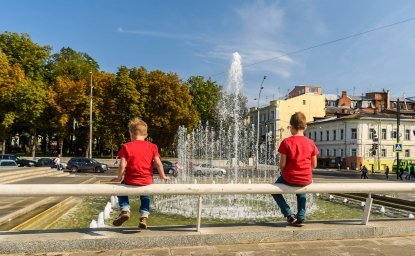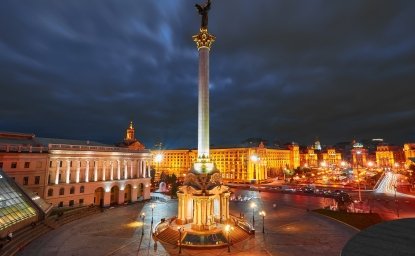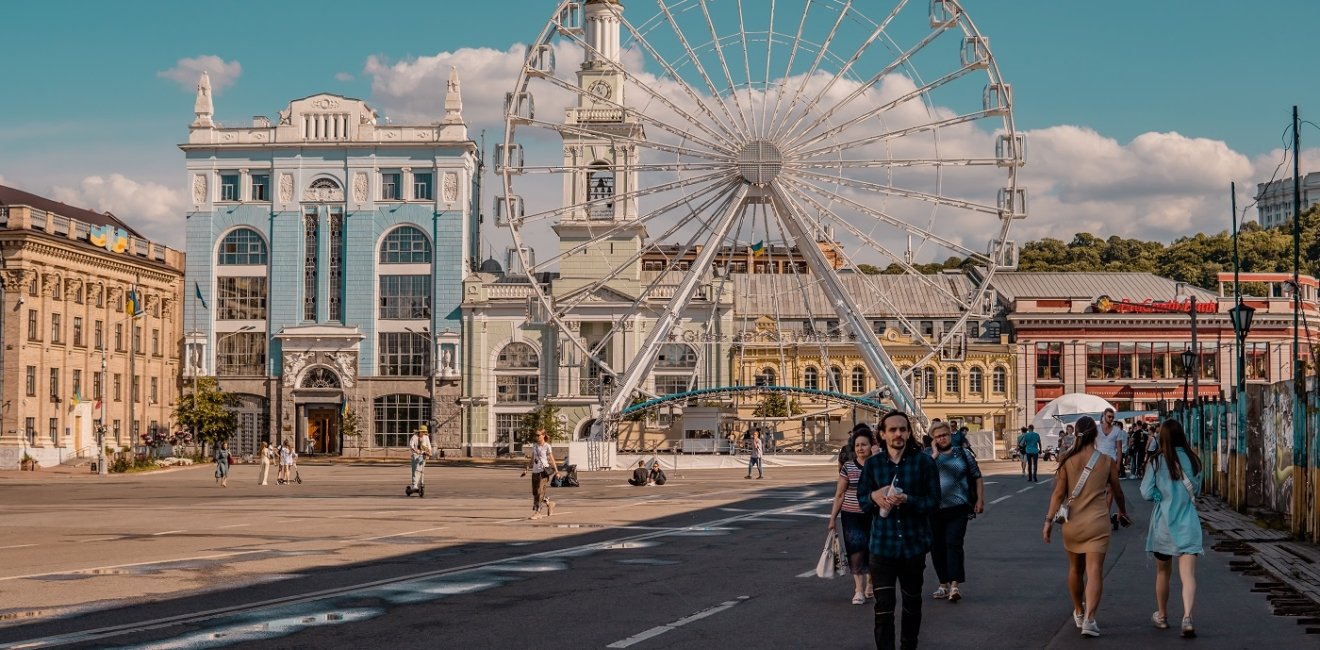
A blog of the Kennan Institute
BY BLAIR RUBLE
For the past several weeks—ever since life began to return to a more normal pace following the Ukrainian victory in the battle for Kyiv—the capital’s tattoo artists have gathered in an abandoned factory in Kyiv’s Podil neighborhood to offer their talents in support of their country’s war effort. Scores of young Kyivans—students, soldiers, young professionals—line up for their “tattoos of courage,” a sign of patriotism and solidarity. Artists create mythical beasts inspired by the Ukrainian flag, images honoring national heroes, and anti-Russian tags, which they ink onto their customers. Typically, fifteen artists will work on five to six dozen customers on any given Saturday, earning around $10,000 to support the war effort.
The factory stands near where some Russian rockets fell during the failed assault, bringing the terror of war to a neighborhood that has become a hipster haven in recent years. Located on the banks of the Dnipro river, Podil historically has been Kyiv’s rough-and-tumble lower town where goods unloaded onto the nearby docks moved straight into markets, wholesale stores, and warehouses.
The neighborhood has served as the more respectable upper city’s entrepôt for a thousand years. Podil even became the city center for a while following the thirteenth-century Mongol invasion. Between 1797 and 1929, its Kontraktova Square (Contract Square) hosted Kyiv’s major annual trade fair. The area was rebuilt in stone and brick following a destructive 1811 fire. Surrounded by steep embankments separating the area from the main city above, Podil remained largely self-contained until the arrival of a funicular connecting the city’s upper and lower towns at the outset of the twentieth century, followed by the metro a half century later.
Historically home to merchants, traders, and small manufacturers of all types, the area developed a notable Jewish community that survived until the night of September 29–30, 1941, when German forces marched them to be slaughtered in the nearby Babyn Yar ravine as part of the extermination of 33,771 Jews. A small Jewish community returned following the war, though the city’s life largely flowed out of the lower town.
The area awakened following independence in 1991. A group of leading Ukrainian scholars led by Vyacheslav Brukhovetsky moved to reestablish the historic Kyiv-Mohyla Academy (which had been founded in 1615, transformed into the Kyiv Theological Academy in 1819, and shut down by the Soviets). Securing several buildings near Kontraktova Square, their efforts made Podil one of postindependence Ukraine’s leading intellectual centers, attracting a steady flow of students, faculty, and visitors. The neighborhood’s vibrant food market grew in popularity while its somewhat down-at-heels ambiance reminded expats and hipsters of New York’s SoHo, Paris’s Marais district (in the fourth arrondissement), and Berlin’s Kreuzberg district. Podil became the sort of neighborhood where an early American ambassador could live while tending bees in his back yard.
As in New York, Paris, and Berlin, gentrification began to push the hipsters out, though not as completely as in those wealthier Western cities. The hipster vibe lived on, with Podil serving as one of the city’s most important “zones of contact” among Kyiv’s various communities and classes. Such areas—and thousands of similar rough edges in cities around the world—are the necessary proving grounds where the diverse becomes transformed into an intercultural resource. They are where accomplished cities become successful.
Like wetlands in the natural environment, such mixing bowls of urban diversity often appear to outsiders to be little more than wastelands. They are the first places to be rebuilt, redesigned, reconceived, and reconstituted when reformers think about “improving” a city. Yet this is a terrible mistake. Like wetlands, zones of contact are among the most productive corners of the urban environment. Like wetlands, such communities must be revitalized from time to time for them to continue to enrich the city at large. They are just the sort of place where tattoo artists would support soldiers fighting on their behalf.
Putin and his cronies have made so many blunders in launching their invasion of Ukraine that it is difficult to elevate any one above the others. Among the many miscalculations, failure to recognize the generations of Ukrainians who grew up in an independent country must rank near the top.
Oriented to the West, these self-reliant children of freedom have fought for their own vision of Ukraine during the Orange Revolution (2004–2005), the Euromaidan Revolution of Dignity (2013–2014), and now. They are Ukraine’s future, and their vision for their country is revealed through their own art forms: rock music, TikTok videos, and tattoos. Their Ukraine is—and will be—the antithesis of everything Putin’s authoritarian Russia represents. Their tattoos of courage are but one more indication of their country’s deep rejection of the society Russians want to impose on Ukraine. More than getting tattoos and making videos for the internet, young Ukrainians are demonstrating that they will resist Russian intrusions with passion, vigor, talent, and persistence well into the future.
The opinions expressed in this article are those solely of the authors and do not reflect the views of the Kennan Institute.
Author

Former Wilson Center Vice President for Programs (2014-2017); Director of the Comparative Urban Studies Program/Urban Sustainability Laboratory (1992-2017); Director of the Kennan Institute for Advanced Russian Studies (1989-2012) and Director of the Program on Global Sustainability and Resilience (2012-2014)

Kennan Institute
The Kennan Institute is the premier US center for advanced research on Eurasia and the oldest and largest regional program at the Woodrow Wilson International Center for Scholars. The Kennan Institute is committed to improving American understanding of Russia, Ukraine, Central Asia, the South Caucasus, and the surrounding region through research and exchange. Read more

Explore More in Focus Ukraine
Browse Focus Ukraine
Ukrainian Society Under Occupation: Hardship and Civic Resilience

Creating Rules of the Game for Contemporary Ukrainian Theater

Ukraine Between 1991 and 2022: The Problem of the Blank Canvas

